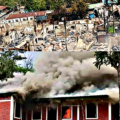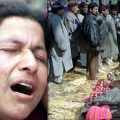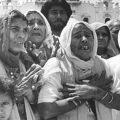Manipur Crisis: Exodus of Manipuri Hindus from Their Homeland?
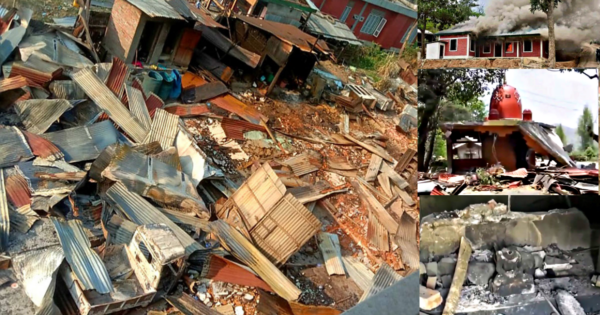
It seems the deadly conflict in Manipur is stubbornly not coming to a halt. The beautiful land of Gaudiya Vaishnava Dharma has now transformed into a lethal war-zone with patrolling and area-domination exercises of the Indian Army continuing in full swing. Amid the ongoing tensions, operations by the security forces to rescue civilians are still continuing. Troops are being freshly deployed as and when the necessity is being felt in a particular area. The conflict, i.e. the Manipur crisis, has left thousands of people homeless and stranded in various shelter camps across the state, with their struggles left unheard and undocumented. All they can do is wait for the situation to return to normalcy as they appeal for peace to be restored.
The pattern of violence has been more intense in certain particular areas such as New Checkon in the Imphal Valley, which have seen a massive demographic change and rapid mushrooming of Churches over the past few years. The repercussions of this conflict are now beginning to be felt in the other neighbouring states as well. In Meghalaya, the tripartite peace talks among the Centre, the Government of Meghalaya, and the outlawed Hynniewtrep National Liberation Council (HNLC) that were supposed to begin formally in the first week of June have now hit a roadblock because of the Union Home Ministry’s prioritisation of the situation in Manipur.
It’s almost more than a month now since the violence began on May 3, 2023 when the Tribal Solidarity March or ‘peace rally’ was organised by the pro-Kuki All Tribal Students’ Union of Manipur (ATSUM), to raise its grievances against the granting of Scheduled Tribe (ST) status to the Meiteis. On May 1, 2023 a missionary organisation – the Tribal Christian Churches Forum – had, in a press release, conveyed solidarity with the ‘peace rally’ to be organised by the ATSUM on May 3. To recall, as per the Census records of 1891, 1901, and 1931, the Meitei/Meetei was recognized as a ‘tribe’. It remained in place till the year 1949.
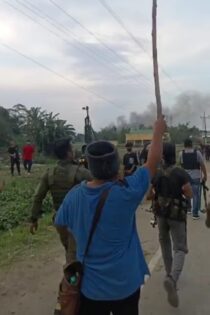
The infamous “Peace Rally” of May 3, 2023
But, from the Gazetteers of 1951 onwards, they were removed from the ST list of the Govt. of India based on a Report of the Sub-Committee on the North-East Frontier (Assam) Tribal and Excluded Areas chaired by the then Premier of Assam Shri Gopinath Bordoloi, J.J.M. Nichols Roy, a Christian politician from present-day Meghalaya, Rupnath Brahma, AV Thakkar, and Mayang Nokcha. This was done without any prior information or communication to the State Government of Manipur and its people. The Ministry of Tribal Affairs, Government of India, was also not intimated. As per the Census of 1951, the population of the Meiteis in Manipur was 59%. This had reduced to 49% in the Census of 2011.
Without any constitutional protection, the Meitei Hindu community has become a vulnerable and marginalised lot in their own homeland. Inclusion of the Meiteis in the list of STs would thus help them preserve and safeguard their ancestral lands, language, culture and traditions. But, we do not yet see the possibility of this happening anytime soon. On the contrary, they are losing their lands and places of worship to the Christians almost every single day. Still, a significant chunk of the Hindu population in the rest of the country is aloof from the pain and sufferings of this community. Perhaps they might also not know about their culture and civilisation till the time their Hindu identity is annihilated completely.
How Did the Manipur Crisis Begin?
The State Government of Manipur was already facing intense resentment from the Kukis on matters relating to the preservation and protection of reserved forests. As per the 1976 Amendment to the Indian Forest Act of 1927, forest is a State subject, making the State Government chiefly responsible for all forest-related issues. The Indigenous Tribal Leaders’ Forum (ITLF) had called for a total shutdown in Churachandpur district from 8am to 4pm on April 28 to protest against the State Government’s survey of reserved and protected forest areas, wetlands and wildlife sanctuaries, and the ongoing eviction drive against poppy cultivation.
It is important to note here that the ITLF is the same organisation that had burnt down a newly-constructed gym-cum-sports facility a day before it was scheduled to be inaugurated by Chief Minister N Biren Singh. The Govt. of Manipur has been endeavouring to provide alternatives to poppy cultivation and thereby prevent illegal drug trafficking and narco-terrorism in the state. But, several civil society organisations of the Kukis and their leaders have tried to project such endeavours of the State Government as anti-tribal, aimed at launching a war against the Kukis through “racial profiling” of the community, thereby instigating them against the Meiteis on communal lines.
In view of their alleged role in poppy cultivation and obstructing the State Government from protecting the forests and forest resources of the state, the Government had, on March 10, 2023 decided to withdraw itself from holding tripartite talks under the Suspension of Operations (SoO) Agreement with two hill-based armed insurgent groups – the Kuki National Army (KNA) and the Zomi Revolutionary Army (ZRA). Besides the drug angle in the conflict, the issue of illegal immigration and the continuous influx of migrants from neighbouring countries like Myanmar and Bangladesh coming and settling down in different regions of Manipur has been a serious concern.
With regard to the issue of undocumented illegal immigrants residing in Manipur, the State Government had constituted a high-powered Cabinet Sub-Committee along with the launch of biometric facial identification to detect the immigrants. The district administration had also started the process of identification and verification of illegal immigrants found settling in the border villages of the various hill districts. Last year, in November 2022, the Manipur Government had extended the temporary suspension of the Free Movement Regime (FMR) along the India-Myanmar border for a period of another three months.
The India-Myanmar border has an FMR of 16km which allows people living along the border to travel without visa restrictions. There are over 250 villages with over 300,000 people living within 10 kilometres of the border who frequently cross the border through 150 small and large formal and informal border crossings. But, it has always been felt that the FMR is one of the primary reasons behind the rapid increase in the number of illegal entries of Myanmar nationals, largely from the Pekon township of the Shan state, into India in view of the deteriorating law and order situation in that country, especially after 2021, when the Army seized power from the elected Govt. of Aung San Suu Kyi.
Few months back from today, the Govt. of Manipur had also availed assistance from the Union Government to complete border fencing and establish 34 police stations along the India-Myanmar border town of Moreh. All these steps of the State Government soon came to be perceived as an open and direct threat to the illegal migrants who had been living in the different hill regions of Manipur for several decades and playing a crucial role in providing support and training to the insurgents. The pro-immigration policy of many Kuki organizations had also led them to protest against conducting a data-collection exercise for a National Register of Citizens (NRC) in Manipur.
Initially, the infamous “peace rally” by the ATSUM was supposed to be held in all the tribal-dominated districts of the state, but it later took place only in the Kuki-dominated district headquarters of Churachandpur, Kangpokpi, and Tengnoupal. Supported openly by Kuki militants, the rally soon took a violent turn in Churachandpur. Forest Beat Offices were set on fire early in the morning. Several questions have arisen in due course of time – Why were these forest offices suddenly burnt down and by whom? Was it a brute manifestation of the anger against the eviction drive carried out by the Government of Manipur against illegal immigrants and encroachers in the reserved and protected forest areas?
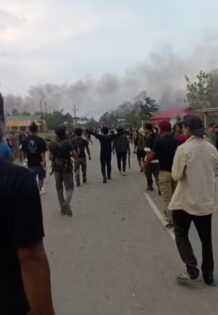
Some scenes from the “Peace Rally”. Protesters were heard raising violent slogans against the Meiteis
Otherwise, what explains the move behind the destruction of Government records on forest areas and settlements? Was there any foreign hand behind this sinister game-plan? In February 2023, 15 temporary kutcha houses near the National Highway at K Sonjang village of Khoupum Protected Forest area in Churachandpur were evicted. It was met with violent resistance by the Kukis. Just a month after this incident, in March 2023, the Kuki Students’ Organisation (KSO) organised a rally in the Kuki-dominated areas of Manipur unlawfully, in complete defiance of CrPC 144. Interestingly, the rally later extended to New Delhi where they appealed to the PMO to stop the eviction immediately.
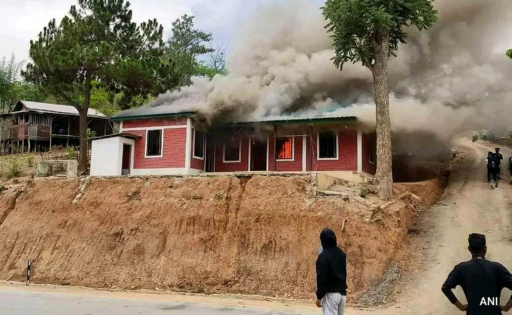
Burning of Forest Beat Office by Kuki militants at Churachandpur
After sometime, it was publicised through the media that the eviction drive at Sonjang was targeted exclusively against the Kuki-Chin-Zo communities by a Hindu “majoritarian” Government. This allegation is, however, far from true. The Government of Manipur’s eviction drive was not targeted against any specific community. The forest land at Khoupum was declared as “Protected” much before Kuki immigration plagued the entire district of Churachandpur. This drive was a part of the policy of the Government to protect the dwindling reserved and protected forest areas of Manipur, most of which are still considered as sacred in the Meitei Hindu belief system.
On April 30, 2023, Shri. Bhupender Yadav, Hon’ble Minister of Labour & Employment, Environment, Forest & Climate Change, Government of India, declared in connection with the Government of Manipur’s eviction drive that the “protection of Reserved Forests and Protected Forests is a State Subject and that the Manipur Government is carrying out a constitutional duty.” Hence, the stand of the KSO with regard to this eviction was illegal and anti-national. It is in this context that targeting of the Forest Offices with the motive of destroying forest records by people of only a certain community could not definitely have taken place without a reason.
It was, undoubtedly, a well-planned and targeted act engineered by certain stakeholders with a deliberate attempt to destroy Government records on land and forest areas after the Government began its anti-encroachment drive against illegal Kuki immigrants. A few days after this incident, the Manipur Tribal Forum filed a writ petition in the Supreme Court of India challenging the order of the Manipur High Court that directed the State Government to submit the latest socio-economic survey and ethnographic report on the matter of providing ST reservation to the Meiteis. As of now, the Manipur High Court has deferred its decision on this issue after the Supreme Court’s intervention.
Interestingly, Kuki organisations did not exhaust judicial options to address this issue. But, resorting to violence on the part of the Kukis while peaceful means were available has raised several uncomfortable questions with regard to the character, political disposition, and the larger conspiracy of the Kuki leadership. Violence seems to be the new normal of the KSO and other Kuki organisations. They could have taken recourse to legal options to voice their concerns and grievances. Moreover, the argument that a perception of fear had generated such widespread violence across the Kuki-dominated districts of Manipur cannot be bought, because the Naga-dominated districts have remained almost completely peaceful.
The dangerous sequence in which the events have unfolded since the 3rd of May has already laid bare the hard truth that the anti-reservation rally organised by the ATSUM was a mere façade and within it was hidden a well-planned, long-term political agenda to destabilise Manipur and eliminate all traces of the Hindu civilisation. But, why did the Kuki community organise the protest rally on this date, i.e. 03.05.2023, against the order of the Manipur High Court dated 27.03.2023? And, if it was a “peace” rally, then from where could the highly sophisticated arms and ammunitions be gathered? Who were the people behind this?
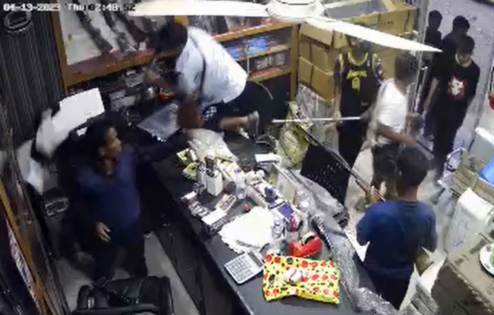
Disturbing Images of the Gun House at Churachandpur being looted
Recently, Kuki groups even reached the residence of Union Home Minister Amit Shah in New Delhi. The Kuki Women’s Forum had submitted a memorandum urging him to provide complete protection to the Kuki villages by establishing a line of military outposts along the foothills of the valley so that it can act as a buffer zone between the Kuki settlements on the one hand and the Meiteis on the other. At the heart of the current Manipur crisis lies an anti-Meitei/anti-Hindu angst that has been reflected through numerous heart-wrenching incidents against the Meiteis in different parts of the state. To call it an ‘ethnic conflict’ implies camouflaging this real issue through the narrative of Western theories related to race and ethnicity.
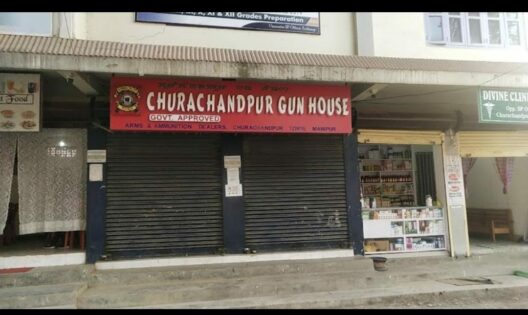
The looted Gun House
Anti-Hindu Nature of the Violence
The violence that initially began with the burning of houses and temples of the Hindu Meitei community by the Kukis at Torbung village of Bishnupur soon escalated to kidnappings and abductions of innocent villagers by armed Christian Kuki militants. In several Meitei villages of Churachandpur district, the militants carried out lootings and arson with sharp daos and knives while at the same time, common Kuki civilians formed human chains on the streets with the objective of blocking the entry of the media and the Press. Numerically speaking, the Meiteis are a minority in Churachandpur. The truth has thus been very cleverly covered up in this complex maze.
A significant section of the Meitei population, both Hindu and Christian, is trapped in a hostage-like situation in several villages of Churachandpur even today. There is already a huge shortage of ration, drinking water, and medical assistance in these villages. The DC complex in Churachandpur still houses thousands of homeless people from the Meitei community who have been evacuated and rescued by the Army from different localities in the district, with more and more people coming in almost everyday. A few BSF camps, the campus of the Manipur Rifles, and the Imphal Airport have also become the places of relief and refuge for these people.
It is an alarming indication for the security of the Indian state that a section of the protesters equipped with sophisticated weapons and multiple bullets and hiding in trenches and bunkers could prevent the entry of the security forces to rescue the affected people.
In a sensational incident, on May 25, a group of around 10 suspected Kuki militants who came down from Thingsat Kuki village and entered Chirik Loitong village in Imphal West district, had abducted an aged Hindu Meitei man, beat him mercilessly, and also looted his farmhouse. But, with reference to this dastardly incident, Kuki propagandists had earlier shown the elderly victim as a Kuki in several videos that later began to circulate in social media.
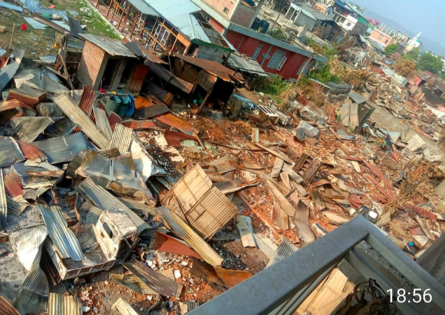
Khumujamba Meitei Colony at Churachandpur destroyed by Kukis
Prior to this, on May 19, in the Dolaithabi area of Imphal East district, several abandoned houses of Hindu Meitei families were set on fire by Kuki militants. They did not just stop at this. These same houses were later occupied by the militants by constructing bunkers. All these incidents are a clear proof of not only the quantum of vengeance being harboured by the Kukis against all non-Kukis, especially the Meiteis, but also a hidden, well-planned agenda to consolidate Lebensraum for the Kukis in several foothills of the Imphal Valley. There are interlinkages of several factors – social, economic, political, cultural, and religious – that are responsible in their own ways for leading to the turmoil in Manipur.
On the night of June 3 around 12.30 am, Kuki militants burnt down a poultry farm owned by a Meitei Hindu family, two houses, and one sawmill. Later, several rounds of shootings and bomb blasts were reported from the Phayeng area of Imphal West district. The militants also attacked several Meitei villages of Bishnupur district by indiscriminate shooting and burning of abandoned houses of the villagers on that same day. They have not even spared our security forces. On June 1, a Commando Sub-Inspector and four State Commando personnel sustained bullet injuries inflicted by Kuki militants at Tangjeng village in Moirang town of Bishnupur.
Again, on June 6, Kuki militants attacked BSF troops deployed at a school in Sugnu town of Kakching district, leading to the death of a young BSF jawan. BSF and troops of the Assam Rifles retaliated to the attack which led to an exchange of fire between the security forces on the one side and the militants on the other. Two days before this ghastly incident, the private residence of Congress MLA Ranjit Singh was set ablaze by Kuki militants among a cluster of houses and shops at Sugnu’s Serou Bazar area. Despite the heavy deployment of security forces, the overall law and order scenario continues to be a serious challenge for the Government in the strife-torn state.
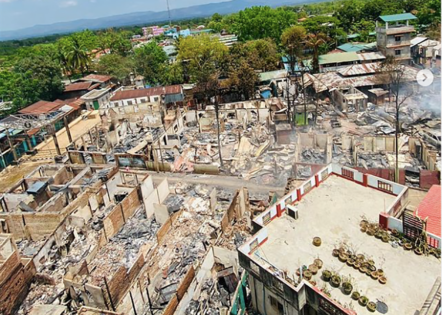
Meitei and Tamil Hindu colonies at the border town of Moreh in Tengnoupal district destroyed
Huge consignments of arms and ammunitions are being seized by the police from different districts almost everyday. In the meantime, an apex body of several valley-based civil society organisations in Manipur – the Coordinating Committee on Manipur Integrity (COCOMI) – has declared a national war against narco-terrorism carried out by the Chin-Kukis in the state, while strongly opposing the plea of Union Home Minister Amit Shah to surrender arms by the youth. It has also urged the Government to establish a Special Village Defence Force in Manipur and initiate immediate action against Kuki militant organisations for their provocative attacks deliberately directed against the Meiteis.
On behalf of the Meiteis, the COCOMI has appealed for necessary and timely action against the defiant Kuki militants as an emergency measure, failing which the Meities are likely to reorganise a fresh wave of protest against anyone targeting Meitei villages and innocent Meitei villagers. It has also demanded for replacing the Assam Rifles with other security organisations like the Border Security Force (BSF) and alike so as to establish a sense of confidence among the masses. With the emergence of new flashpoints in the conflict every single day, the situation is becoming too challenging for the security establishment to deal with.
The districts of Churachandpur, Kakching, Kangpokpi, and Imphal West have been caught in an unending crossfire between Kuki militants and the security forces. Multiple incidents of violence, including arson and shootings, are being reported from different parts of the state. It is an extremely sad and unfortunate situation for all those people who are still housed in the refugee camps, battling a daily struggle for existence. They spend the night amid continuous sounds of firing and gunshots. When is this violence going to end? And, even after it ends, will the overall situation of the state and relationships among the different communities be the same again? Will the perpetrators be ever brought to the book?
Kuki Violence & the Propaganda Behind
An important point, however, to be noted here is that the attacks of the Kuki militants have not been merely confined to the Meiteis and the Nagas of Manipur. Other numerically smaller in number Hindu communities of the state such as the Tamils residing in the Indo-Myanmar border town of Moreh and the Nepali-speaking Gorkhas have been equally affected. Many houses of the Tamil Hindus of Moreh have been burnt down by radical Christian groups. This community has made Manipur their home and are very well-integrated with the Manipuri Hindu society and its culture. The same holds true for the Gorkhas as well.
With a population of 63,756 persons (as per Census 2011), a significant majority of the Gorkhas are engaged as defence personnel, farmers, marginalised labourers, or in small business enterprises. Their settlements are scattered across various regions of Manipur of which the majority are concentrated in the hill districts of Kangpokpi and Senapati, besides Imphal West & Imphal East, Kakching, Tengnoupal, and a few areas adjoining Moreh. There are 154 Nepali-speaking Gorkha villages in the Kuki-dominated Kangpokpi district of Manipur, where Kuki militants under the Suspension of Operations (SoO) Agreement with the Government and various other non-SoO Kuki militant groups are in operation.
The ongoing conflict has adversely impacted the poor Nepali Hindu Gorkha families as a result of heavy extortion by the Myanmar-based Kuki militants who are now on a spree to eliminate them from their own lands and villages by forcefully taking away their herds of cattle and then demanding money for the purchase of sophisticated arms and weapons. Most of these people from several vulnerable and sensitive villages of Kakching, Tengnoupal, Moreh, Imphal East, and other adjacent districts have fled to other safe areas. It is very important that the Government safeguards the rights and privileges of these minority Hindu communities.
They need to be provided a safe and secure environment with the necessary deployment of security so that the SoO ground rules are strictly adhered to by the militants, and the non-SoO groups are completely banished. Although the Government has constituted the three-member Justice Ajai Lamba Commission of Inquiry to probe into the incidents of this violence, but, at this moment of crisis, unfortunately, the true facts have been brushed aside from the public eye. Several fabricated narratives manufactured by so-called “intellectuals” and a few civil society organisations with vested interests are doing the rounds in both national and social media. As a result, the real reasons behind the violence have been misrepresented.
The larger objective behind this has been to corner the Hindu Meitei voices and consolidate the false story that the Kuki-Chin-Zomis have always been the main victims of violence and discrimination at the hands of the Meiteis. It is important to put across the real issues pertaining to the Manipur crisis in the right perspective beginning from the genesis of this violence. Politics doesn’t always work the way we assume it to be or the way it seems on the surface. It would be wrong to think that the Meitei community claims exclusive hegemony of power over the politics of the state. In this regard, the oft-repeated argument is that Manipur is ruled by a Meitei Chief Minister, and political representation of the valley versus the hills is in the ratio of 40:20.
This, however, is only a part of the story and far from the truth. Because, if we look back into the history of Manipur since the time it attained statehood in the year 1972, the first Chief Minister was a Pangal, i.e. a Manipuri Muslim named Md. Alimuddin. This was at a time when Muslims constituted less than 8% of the state’s total population. Md. Alimuddin served twice as the Chief Minister of Manipur. The next Chief Minister was a tribal leader named Yangmaso Shaiza who also served twice in his capacity. The longest serving Chief Minister of Manipur till date also happens to be a tribal leader Shri. Rishang Keishing. The first Speaker of the Manipur Legislative Assembly Shri. TC Tiankham was from the Kuki community.
Further, with respect to the hill-valley ratio of the total number of reserved and unreserved seats in the Assembly, there are a total of 40 unreserved seats in the Imphal Valley, with one lone seat in the Kangpokpi hills district. Any citizen of India can contest from these 41 unreserved seats put together. But, the number of reserved Assembly seats is 19, which are exclusive ‘tribal seats’ meant to be contested by the Christian Nagas and the Kukis. Moreover, if we also look at the data with regard to the Government of Manipur’s budget allocation for the valley and the hills over the past few years, the hill areas of Manipur with a population of 42.83% have received 45.75% developmental funds in the financial year 2020-21.
Budget Allocation (Source: Govt. of Manipur Report)
|
Year |
Valley |
Hills |
|
2018-19 |
63.21% |
36.79% |
|
2019-20 |
56.30% |
43.70% |
|
2020-21 |
54.25% |
45.75% |
Most importantly, this budget allocation for the Christian-majority hill districts has been made by the current BJP Government headed by N Biren Singh, a Meitei Hindu himself. Hence, looking at the above data, the oft-heard propaganda that the tribal-dominated Christian hill districts of Manipur have always been at the receiving end in terms of allotment of funds stands completely false. It is a concocted story spread by a well-funded and well-organised lobby of ideological propagandists, missionaries and a few media houses of our country. In fact, there are several areas in the hills which are far more developed than the Valley in terms of education and healthcare facilities.
It is more important that we look into the larger aspect of fund utilisation, i.e. whether the allocated funds are properly utilised for the respective developmental purposes they are being allotted? Or, are they being siphoned off to the insurgents active in the hill districts? Whatever the case might be, but the fact of the matter is that there has been no discrimination against the hill residents of Manipur in terms of development-related policies and programmes. A much more serious issue that needs to be resolved at the earliest is the unabated migration of the Kukis to Manipur from across the international border with Myanmar.
Missionary Agenda Behind?
A 200-year old Shiva temple was razed by using a bull-dozer and its murti desecrated at Koubru Leikha village under the Kuki-dominated Kangpokpi district administration. At Thingam-phai Meetei Lekai in Churachandpur, a violent Kuki mob vandalised and destroyed a temple of Eputhou Pakhangba and also burnt its seven-coloured Salai Taret flag in retaliation against the demolition of Churches illegally constructed on Government land. However, since the beginning of the Manipur crisis, a certain section of the academia has left no stone unturned to continuously bring to the public notice the series of incidences of vandalisation of Churches by conducting various seminars and conferences on this sensitive topic.
Such acts are undoubtedly unfortunate and condemnable. The violence orchestrated by the Kuki militants in the first place and the subsequent aggression committed by them upon Hindu temples in the hills led to disastrous consequences that adversely impacted some Kuki Churches. But, the fact that the destruction of these Churches was a retaliatory act driven by the violent psyche of an agitated mob who is compelled by circumstances to take the law into its own hands, was never highlighted. It is therefore very important to enquire into the reasons behind the occurrence of such unfortunate incidences of desecration and destruction of religious places of worship of both the Hindus and the Christians.
Behind the destruction of Hindu religious places of worship there is always in place a well-designed and well-formulated strategy by the Mullah-Missionary-Communist combine to not just harass Hindus but also eliminate everything associated with the Hindu belief system, traditions and way of life. We see a repetition of the same again in Manipur. The Churches have been instrumental in instigating the common Kuki civilians against the Meiteis. In the past as well, there have been several such instances in the hill districts of Manipur when the construction of Hindu temples had to be stalled all of a sudden because of vehement resistance by the Kuki Churches and their affiliated organisations including the militant groups.
Meitei Temples Destroyed by Kukis in the Recent Violence (The list is not exhaustive)
|
Temple/Laishang |
Place |
Sub-Division |
District |
|
Mahadev |
Koubru Leikha |
Saitu Gamphazol |
Kangpokpi |
|
Nungthong Lairembi (Devi) |
Serou |
Waikhong |
Kakching |
|
Lainingthou Sanamahi |
Thinungei |
Bishnupur |
Bishnupur |
|
Kondong Lairembi (Devi) |
Moreh |
Moreh |
Tengnoupal |
|
Langol Lairembi (Devi) |
Langol |
Imphal West |
Imphal West |
|
Thongak Lairembi (Devi) |
Langol |
Imphal West |
Imphal West |
|
Ima Panthoibi (Devi) |
Torbung |
Moirang |
Bishnupur |
|
Ingourok Mahadev |
Leimakhong |
Kangpokpi |
Kangpokpi |
|
Ireima (Devi) |
Moreh |
Moreh |
Tengnoupal |
|
Maikeingakpa |
Zoveng Meitei Leikai |
Churachandpur |
Churachandpur |
|
Ibudhou Pakhangba |
Meitei Leikai |
Churachandpur |
Churachandpur |
The Church is a professional criminal Christian organization that has either directly or indirectly been responsible for killing millions of innocent non-Christians across the world. Murder, looting, arson, kidnapping, and rape are very effective and well-thought-out methods of religious conversion and terrorism funded by the Church. Unfortunately, in India, the Hindu society and those in positions of power and authority have deliberately chosen to ignore this fact, resulting in an unending saga of violence between Dharma and Adharma. In North-East India, any practice, symbol or way of life associated with Hindu Dharma is seen with contempt and ridicule by the missionaries.
They have done everything possible to ensure that the last-remaining groups of Hindu population in this part of the country, whether it be the Meiteis of Manipur, the Jaintias of Meghalaya, or the Tangsas and Tutsas of Arunachal Pradesh, etc. are either converted or annihilated. In the Khasi Christian versus Hindu conflict in Meghalaya (1980), Christian versus Hindu conflict in Tripura (1980-1990), Mizo Christian and Reang-Chakma conflict in Mizoram (1997), conflicts between the Hmars and the Dimasas (2003), Karbis and Dimasas (2005), Zeme Naga and Dimasas (2009), and Bodo Christians and Bodo Hindus (2010) in Assam, etc. Hindus have always been on the losing side.
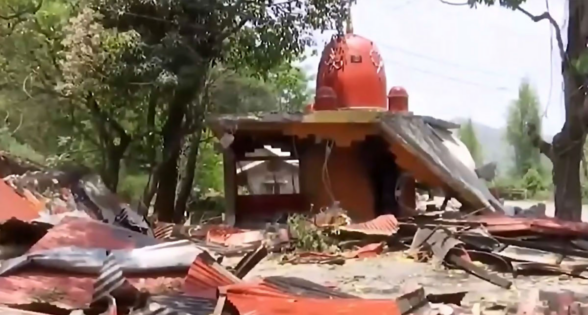
Shiv Mandir at Koubru Leikha village in Kangpokpi district destroyed by Kukis
After the riots, the Church-sponsored peace committees immediately come forward to provide relief and assistance. Very soon, a propaganda narrative based on Hindus committing violence upon the Christians is sold out to the media through many different ways and means. The administration has, more often than not, turned a blind eye to such cases of atrocities against Hindus and Hindu religious places of worship in the North-East. The Churches here are more akin to political institutions than religious/sacred places. Both the Government and the society are trapped in a complex web woven by the Church involving drugs and narcotics, arms and guns.
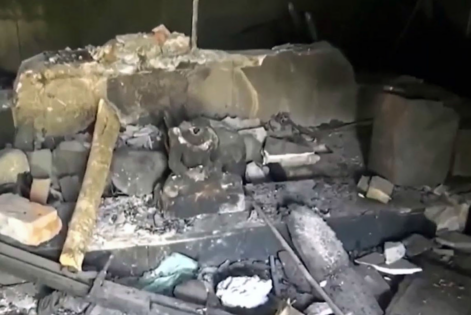
The murti of Mahadev desecrated
Many important policies and decisions of the Government, especially in the states of Mizoram, Meghalaya, and Nagaland, are influenced by the Church. It has been a well-coordinated, long-term strategy of the missionaries to destroy every trace of the Hindu civilisation and culture from the North-East. Churches are being regularly built in each border village of the Meiteis in the hill districts of Manipur. These Churches serve as the dens of the Christian Naga and Kuki militants. Deadly weapons and drugs are hidden on their roofs. When Hindus protest against their dubious activities, the Christian terrorists scare them away by firing gunshots.
It may be recalled here that on June 14, 2001, the Central Government had decided to implement the ceasefire with the Isak-Muivah faction of the National Socialist Council of Nagaland or NSCN (I-M) in the Naga-dominated areas of Manipur. However, this decision was perceived by the Meitei Hindus of Manipur as a threat to the territorial integrity of their state. On July 26, 2001, they held several protest rallies in different parts of the Imphal Valley in which many people from the community were killed in police firing. More than a thousand Meitei Hindus have sacrificed their lives in defence of their motherland since 1947, about which the rest of the Hindu society is still not aware.
Not just the Church and the Kuki militants, but a corrupt nexus of intellectuals, politicians, and the bureaucracy is behind the escalation of the recent Manipur crisis. Quite shockingly, even after 10 days since the violence began, several houses of Hindu Meitei families at Torbung Bangla area continued to be set on fire by militants. A Press Statement was issued by 10 Kuki-Chin MLAs representing the districts of Saitu, Saikul, Singngat, Henglep, Churachandpur, Kangpokpi, Tipaimukh, Tengnoupal, Thanlon, and Saikot. They raised the allegation that the violence in Manipur was unleashed upon the Chin-Kuki-Mizo-Zomi tribal groups by the majority Meitei community, tacitly supported by the Government.
The political aspiration of separation from Manipur harboured by these communities since a long time is now being used by the Kuki political leaders to seek a ‘Separate Administration’ under the Constitution of India. But, amidst all these, it is the Meitei Hindu community who is on the brink of losing its identity, culture and civilisation. With their declining numbers almost every passing decade, they have been pushed towards further annihilation as a result of the recent spate of violence. Every aspect of Manipur’s rich cultural heritage from Manipuri cuisine to Manipuri dance, music and art forms signifies an inseparable association with Hindu Dharma. It is high time now that we save them. Else, no one else will.
Acknowledgements: A special note of thanks to Vladimir for being a pillar of support in this work on the Manipur crisis. Thanks to Jayalakshmi Chanu and Babeena Laishram, my former students, for sharing with me the pictures.
Disclaimer: The facts and views expressed here are solely of the author. My India My Glory does not assume any responsibility for the validity or information or images shared in this article by the author.

